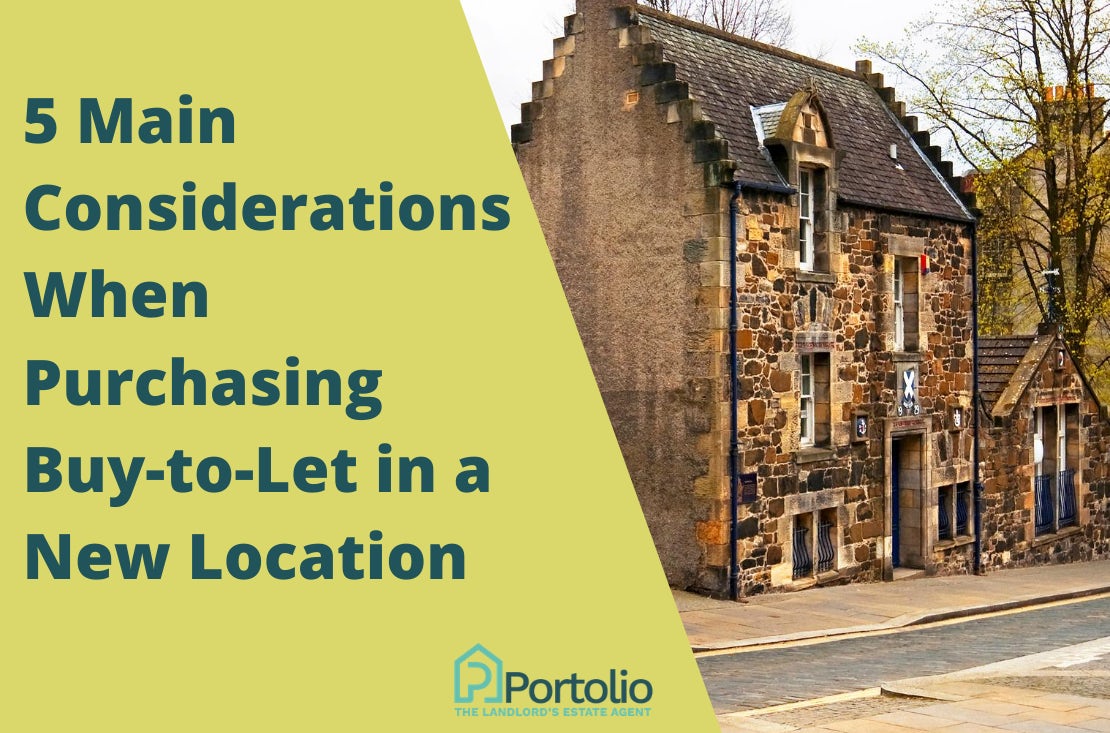Unsure if purchasing buy-to-let in a new location is a good idea?
As humans, we have a built-in fear of the unknown – and a tendency to stick with what we know.
Maybe you already have a few buy-to-let properties under your belt, and you’re used to investing in one specific area – because you know it, and it works for you.
However, you may have seen a good opportunity spring up somewhere further afield – like Glasgow, for example, with its stronger yields and affordable properties – and be feeling some hesitation about whether it’d be a good move.
Being known as one half of the Estate Agent for Landlords, I always say to people not to be discouraged from a good opportunity due to fear of the unknown.
But how do you know if investing in a new area is a genuinely good opportunity, and the right thing for you to do at the moment?
With that in mind, I’ve put together some of the biggest considerations to think about when purchasing buy-to-let in a new location, so that you can make a more informed choice.
1. Will it be popular with tenants?
In other words, what’s the lettability of the property like? Is it close to local amenities, transport links, and with some decent outdoor space (not necessarily a private garden)? If the property is not in a city, what’s the broadband speed in the area like?
More and more people are now working for home, so is there space for someone to place a desk? If they do want to travel into work and avoid public transport, is there adequate bike storage?
TIP: We’ve gone into a little more detail about some of the things to look for when investing in your next property, via our recent blog.
2. What’s going on in the area?
Research, research, research! Look up any development news in the area, and take to Google Maps and Google Streetview to get an idea of what’s going on locally. It’ll give you a better idea of local amenities, transport links (like I mentioned above) but also anything new happening.
Exciting new developments in the area – or gap sites you can look up council planning for – will be a good indication that the property is in a good area for potential capital growth. It’ll also give you a good idea of other surrounding properties and they’re occupied and well-kept.
I also like to use Google Streetview to check back on the property at different points over the past 10 years, but that’s just me – I find it really interesting. All of these have an impact on the property’s perceived value.
TIP: Whilst you’re doing this, make a note of any questions you want to ask the current owner. It could be they have the answers you need.
3. What’s the capital appreciation like in the area?
Next, it’s so important to check the capital appreciation of the area. Check what the property has previously sold for, and what properties like it are selling for now in the local area. What are house prices like now compared to over the past few years?
Don’t forget to check the market rent for the area, as well as how much the property has gone up in value over the past few years.
TIP: For fast property insights, there’s a Google Chrome extension for that (because of course there is)! Advanced Property Insights is free, and provides info from a range of different sources.
4. Can you find a good, recommended letting agent?
If you’re buying a property without knowing the area, and especially if it’s quite a distance away from you, you’re going to need a letting agent you can trust, to organise regular maintenance and management of the property.
They’ll be able to take care of all of the necessary landlord certificates, as well as arrangement urgent repairs and communicating with your tenants if there are any problems.
I’d recommend looking online and doing a fair bit of research on the likes of Google Reviews, Facebook etc. to see what people are actually saying about a particular letting agent – rather than just going with testimonials displayed on their own website.
Buying an already tenanted property means you have the option of continuing to use the existing letting agent – who will have a great understanding of the property, history of repairs, and a good existing relationship with the tenants.
TIP: A good specialist estate agent should be able to support you to find a new letting agent if required.
5. Where does this property fit into your strategy?
Finally, think about your overarching plan, or strategy, and how this property is going to fit into it. Are you planning on buying more than one property in the area? It’s always wise to have a diverse property portfolio, to spread the risk.
Don’t forget to consider your exit strategy; if you buy this property now, what is your exit strategy going to look like – what steps will it involve?
It could be a buy-to-let you want to sell in five years time, or hold onto for the next 30 – you may even want to pass it onto your children. If you’re only looking to buy one property in this area, is your goal going to be based on yield or capital growth?
Purchasing a buy-to-let in a new location – in other words, somewhere different than you’re familiar with – often means thinking about your reasons even more than usual.
If the property needs work – or will do in the next five years – how will you plan for that?
These are all vital things to consider before taking the plunge.
One of the best options for buying remotely
Especially if you’re buying long-distance – or at least in an area you’d have to travel a bit to get to – buying tenanted property is a great option. It means you can receive instant rental income from Day 1, without having to worry about void periods or getting the property ready for tenants.
It’s also really simple to do, despite it not being an option everyone is aware of; the tenancy agreement for the property simply changes hands. You can even choose to keep the same letting agency that’s already managing the property.
In the past six months, a couple of our clients have invested in tenanted properties in Dundee and Aberdeen, when previously they’d only held properties in Edinburgh – these were unfamiliar territory for them to venture into, but they were excited at the prospect of purchasing buy-to-let in a new location.
Because the properties were already tenanted, it meant that there was no need to redecorate or get the property ready for tenants moving in – and it also meant they could enjoy rental income on Day 1 of ownership.
NOTE: They still had to decide on whether to keep the existing letting agent, or find a new one that would help them with the management/maintenance of the property.
Advice from the property pros
The advantage of looking in other areas outwith the bigger cities is that the buy-to-let yields can be much more attractive – as long as you do your research and due diligence.
If you can visit the property first, we recommend you do, rather than only attending a virtual viewing (despite them being the future). Although, especially over lockdown, some people have been buying properties without viewing them in person!
Still unsure of buying in an area you’re unfamiliar with? I’d recommend speaking to a specialist estate agent who can advise you further – it could be that they have a better idea of the area, or can spot something you’ve maybe missed.
They may also be more familiar with how the different markets operate, as using the same tactics you’re used to (offering over or under home report value) may not work in a different area, and can tell you what properties are going for opposed to home report values.
In summary…
Thanks for reading, and I hope you’ve found this blog helpful when considering purchasing buy-to-let in a new location.
There are a few things to consider before making that leap (see above), but in the end, I always say to trust your gut instinct when it comes to buy-to-let.
If you’re looking for free (and impartial) advice on buying tenanted property in new locations (in Scotland), feel free to get in touch with us today.
We’d love to hear from you!
Written by Chris Wood, MD & Founder of Portolio
Get in touch on 07812 164 842 or email [email protected]


Comments